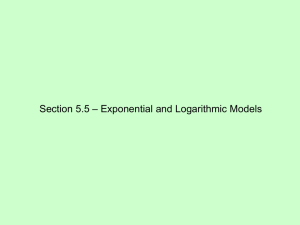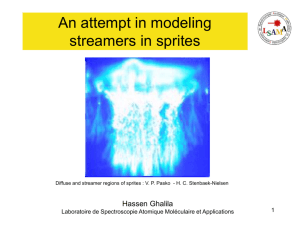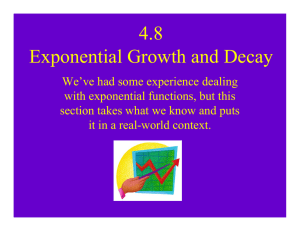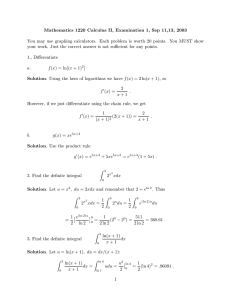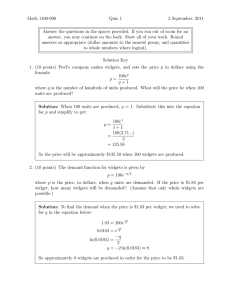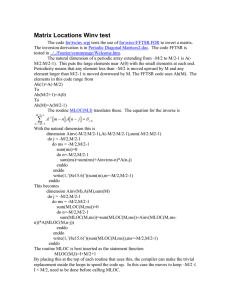Suppose your best friend won $1000 in the lottery. ... you are taking calculus, your friend comes to you for...
advertisement
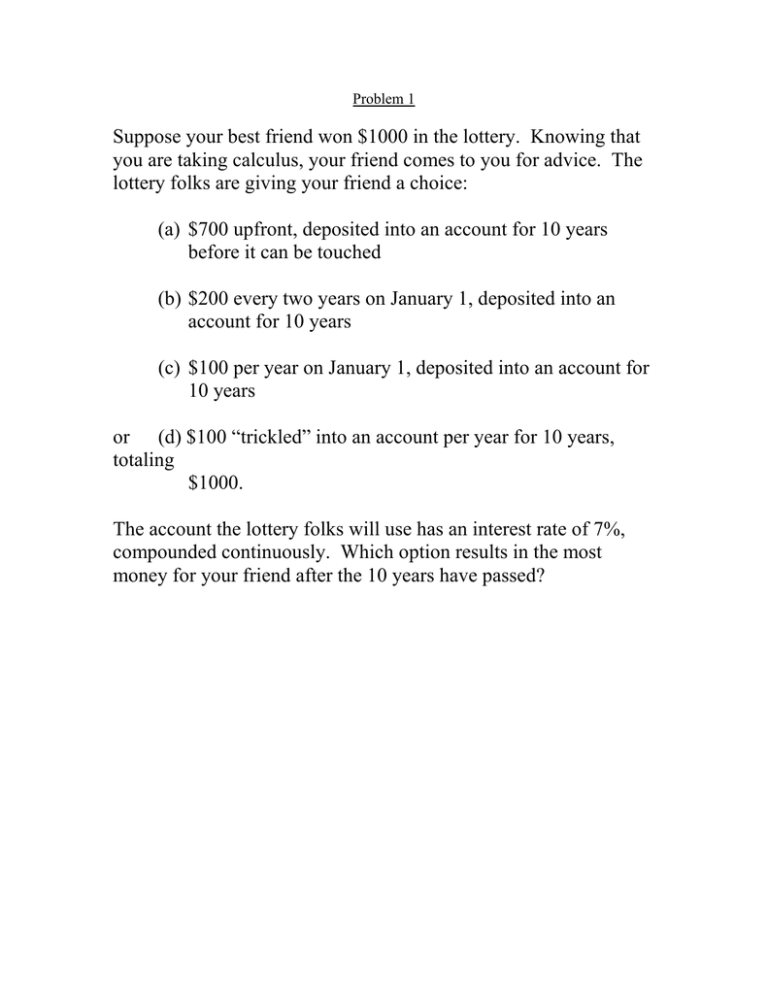
Problem 1 Suppose your best friend won $1000 in the lottery. Knowing that you are taking calculus, your friend comes to you for advice. The lottery folks are giving your friend a choice: (a) $700 upfront, deposited into an account for 10 years before it can be touched (b) $200 every two years on January 1, deposited into an account for 10 years (c) $100 per year on January 1, deposited into an account for 10 years or (d) $100 “trickled” into an account per year for 10 years, totaling $1000. The account the lottery folks will use has an interest rate of 7%, compounded continuously. Which option results in the most money for your friend after the 10 years have passed? Option (b) Date of Deposit Jan. 1, 2007 Jan. 1, 2009 Jan. 1, 2011 Jan. 1, 2013 Jan. 1, 2015 Time invested 10 years 8 years 6 years 4 years 2 years Total Value A = 200e (.07 )(10) = 402.75 A = 200e (.07 )(8) = 350.13 A = 200e (.07 )( 6) = 304.39 A = 200e (.07 )( 4) = 264.63 A = 200e (.07 )( 2) = 230.05 Total Value After 10 Years = Sum of third column = 200e (.07 )( 2) + 200e (.07 )( 4) + 200e (.07 )( 6) + 200e (.07 )(8) + 200e (.07 )(10) = 230.05 + 264.63 + 304.39 + 350.13 + 402.75 = $1551.95 Let ∆t = 2 (the time between deposits). Total Value After 10 Years = 2 ⋅ 100e(.07 )( 2) + 2 ⋅ 100e(.07 )( 4) + 2 ⋅ 100e(.07)( 6) + 2 ⋅ 100e(.07 )(8) + 2 ⋅ 100e(.07 )(10) = ∆t ⋅ 100e(.07)( 2) + ∆t ⋅ 100e(.07 )( 4) + ∆t ⋅ 100e(.07 )( 6) + ∆t ⋅ 100e(.07 )(8) + ∆t ⋅ 100e(.07 )(10) = sum of areas of 5 rectangles. Option (c) Date of Deposit Jan. 1, 2007 Jan. 1, 2008 Jan. 1, 2009 Jan. 1, 2010 Jan. 1, 2011 Jan. 1, 2012 Jan. 1, 2013 Jan. 1, 2014 Jan. 1, 2015 Jan. 1, 2016 Time invested 10 years 9 years 8 years 7 years 6 years 5 years 4 years 3 years 2 years 1 year Total Value A = 100e (.07 )(10 ) = 201.38 A = 100e (.07 )(9 ) = 187.76 A = 100e (.07 )(8) = 175.07 A = 100e (.07 )( 7 ) = 163.23 A = 100e (.07 )( 6 ) = 152.20 A = 100e (.07 )( 5) = 141.91 A = 100e (.07 )( 4 ) = 132.31 A = 100e (.07 )(3) = 123.37 A = 100e (.07 )( 2 ) = 115.03 A = 100e (.07 )(1) = 107.25 Total Value After 10 Years = Sum of third column = 100e(.07)(1) + 100e(.07 )( 2) + 100e(.07 )(3) + 100e(.07 )( 4) + 100e(.07 )(5) + 100e(.07 )( 6) + 100e(.07 )( 7) + 100e(.07 )(8) + 100e(.07 )(9) + 100e(.07 )(10) = ∆t ⋅ 100e(.07)(1) + ∆t ⋅ 100e(.07 )( 2) + ∆t ⋅ 100e(.07 )(3) + ∆t ⋅ 100e(.07 )( 4) + ∆t ⋅ 100e(.07)( 5) + ∆t ⋅ 100e(.07 )( 6) + ∆t ⋅ 100e(.07 )( 7) + ∆t ⋅ 100e(.07 )(8) + ∆t ⋅ 100e(.07 )(9) + ∆t ⋅ 100e(.07 )(10) = 107.25 + 115.03 + 123.37 + 132.31 + 141.91 + 152.20 + 163.23 + 175.07 + 187.76 + 201.38 = $1499.51 =sum of 10 rectangles Problem 2 Suppose we know that we want the Total Value (amount of continuous money flow) to be $500,000 after 10 years at an interest rate of 7%, compounded continuously. What should P, the constant rate of investment per year, be? That is, how much money needs to trickle in each year so that we walk away with $500,000 at the end of 10 years?
